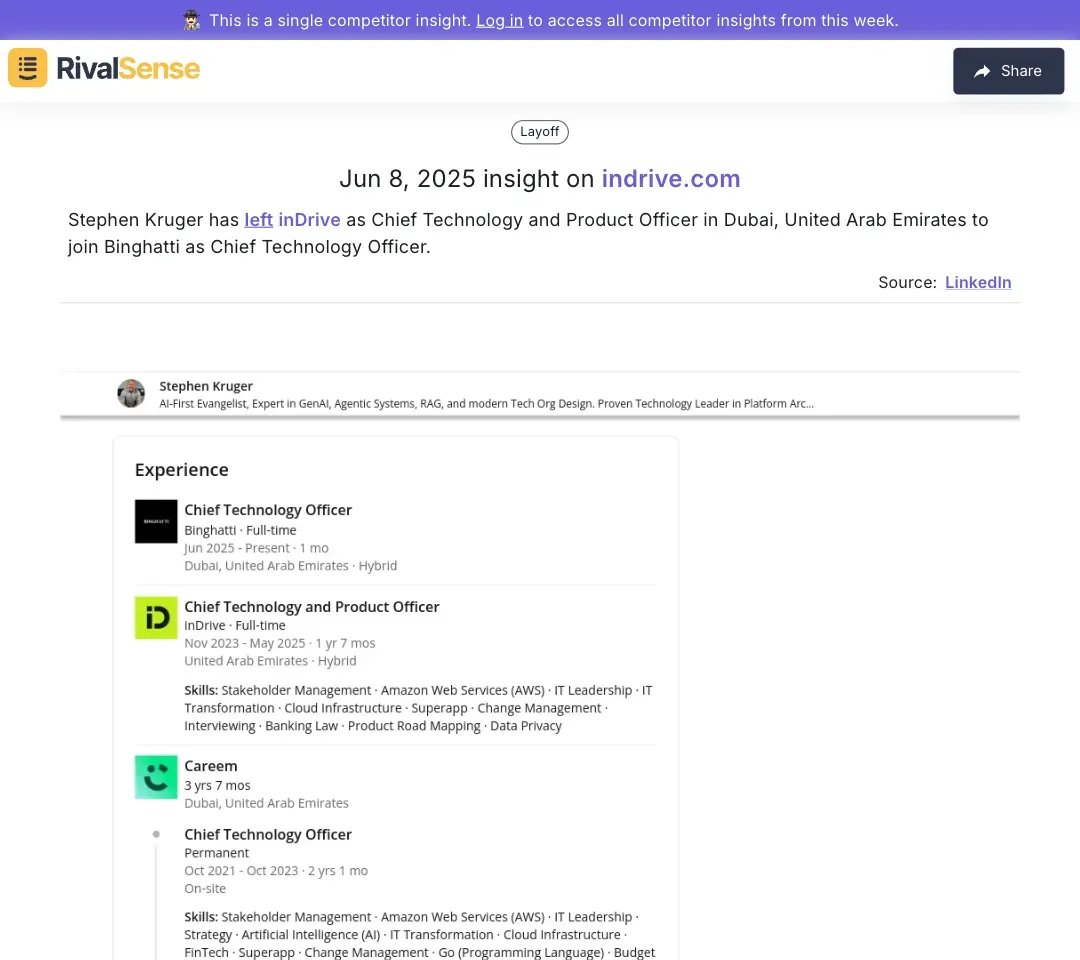How inDrive's Leadership Shift Empowered Binghatti's Tech Edge
InDrive established itself as a ride-hailing innovator with strong market presence before its leadership transition. As competition intensified, strategic realignment became essential for sustaining growth. The leadership shift aimed to inject fresh perspectives, enhance technological innovation, and better align with evolving market dynamics. This transformation wasn't merely about personnel changes but represented a fundamental reset of strategic direction.
Binghatti, facing tech scalability challenges, seized this opportunity to leverage inDrive's expertise. For business leaders, this underscores how adaptive leadership and partnerships can address operational gaps. Consider these actionable steps:
- ✅ Audit leadership alignment quarterly against strategic goals
- ✅ Proactively recruit executives with complementary innovation skills
- ✅ Initiate exploratory talks with tech-advanced potential partners
The Leadership Transition: A Catalyst for Change
Executive reshuffles often signal strategic pivots that create ripple effects across industries. inDrive's leadership overhaul introduced tech-focused visionaries who prioritized agile methodologies and scalable solutions. This realignment created unexpected synergies with Binghatti's ambition to dominate tech-driven real estate.
Real-World Executive Movement Insight

Stephen Kruger transitioned from Chief Technology and Product Officer at inDrive to Chief Technology Officer at Binghatti.
Tracking such executive moves provides critical intelligence:
- Predict strategic shifts: Leadership changes often precede new tech initiatives or market expansions
- Identify talent opportunities: Top executives moving between competitors reveal skill availability
- Anticipate partnerships: Cross-industry moves signal emerging collaboration patterns
Actionable steps post-transition:
- 📊 Benchmark new leaders' expertise against your innovation roadmap
- 🤝 Host quarterly cross-company innovation workshops
- ⏱️ Establish 30/60/90-day impact metrics for leadership changes
Empowering Binghatti's Tech Edge: The Strategic Partnership
The collaboration transformed Binghatti's technological capabilities through knowledge transfer and co-creation. inDrive's leadership introduced agile frameworks that accelerated Binghatti's development cycles. This went beyond tool adoption to instill technology-first decision-making across departments.
Key initiatives driven by the partnership:
| Initiative | Impact | Timeline |
|---|---|---|
| AI analytics platform | 40% operational efficiency gain | 8 months |
| Blockchain transactions | 25% faster processing | 6 months |
| IoT integration | 30% energy cost reduction | 10 months |
Implementation checklist:
- [ ] Map technology gaps against partner capabilities
- [ ] Co-develop phased integration roadmap
- [ ] Establish monthly innovation KPIs
- [ ] Create cross-company tiger teams for rapid prototyping
Competitive Advantage Gained: Analyzing the Outcomes
Binghatti's market position shifted from industry participant to innovation leader post-collaboration. Customer satisfaction scores increased by 35% while product launch cycles shortened by 50%. Competitors struggled to match these tech-driven improvements.
Stakeholders reported three transformational effects:
- Faster decision-making through decentralized tech approvals
- Enhanced talent attraction from association with cutting-edge projects
- Premium pricing power for AI-enhanced services
Sustaining competitive edge:
- 🔍 Conduct quarterly competitor capability assessments
- 🚀 Allocate 15% R&D budget for partnership-driven innovation
- 📈 Monitor customer reviews for tech satisfaction indicators
Lessons Learned and Best Practices
This case reveals how leadership mobility can create unexpected competitive advantages. Companies that systematically track executive movements gain first-mover advantage in partnership opportunities. The most successful transitions combine cultural integration with measurable tech objectives.
Best practice framework:
Vision Alignment → Talent Integration → Tech Transfer → KPI Measurement
Critical implementation phases:
- Pre-transition
- Audit partner leadership's innovation track record
- Identify complementary tech stack opportunities
- Integration (0-6 months)
- Launch joint proof-of-concept projects
- Establish cross-company communication channels
- Scale (6-18 months)
- Convert successful prototypes to production systems
- Develop shared IP ownership agreements
Conclusion: The Future of Strategic Leadership in Tech
Leadership transitions represent untapped opportunities for technological leapfrogging. The inDrive-Binghatti case demonstrates how executive mobility can transfer capabilities across industries. Companies that institutionalize competitor monitoring gain strategic advantages in partnership formation and talent acquisition.
Forward-looking leaders should:
- 🧭 Map competitor leadership trees quarterly
- 🤖 Automate tracking of executive movements and affiliations
- 🌉 Build bridges to companies gaining top tech talent
Ready to transform leadership insights into competitive advantage?
Try RivalSense Free to monitor competitor leadership changes, product launches, and strategic moves. Get your first automated competitor report today and never miss pivotal market shifts again.
📚 Read more
👉 Tracking Indirect Competitors Through Website Changes
👉 How BetterMe Dominated the Health App Market Using Competitor Intelligence
👉 5 Actionable Strategies to Leverage Competitor Insights from Events
👉 Navigating Tariff Uncertainty: How Competitive Intelligence Becomes Your Strategic Compass
👉 Decoding Executive Moves: How Stephen Kruger's Transition Impacts Competitive Landscapes
